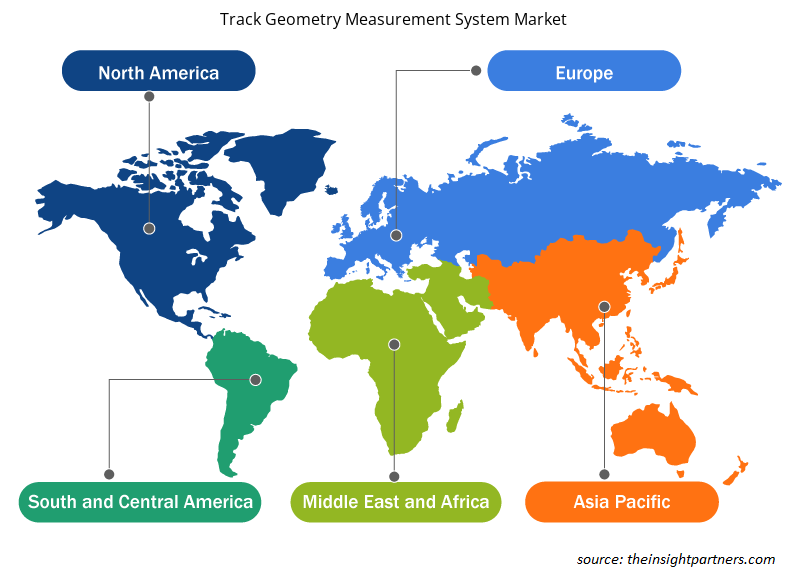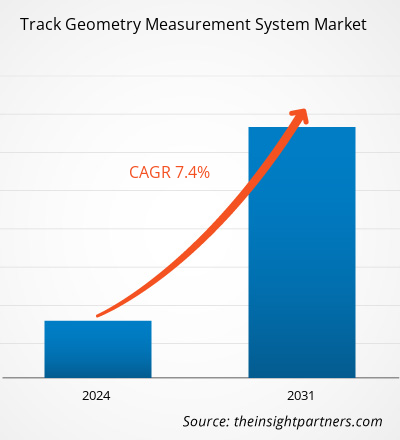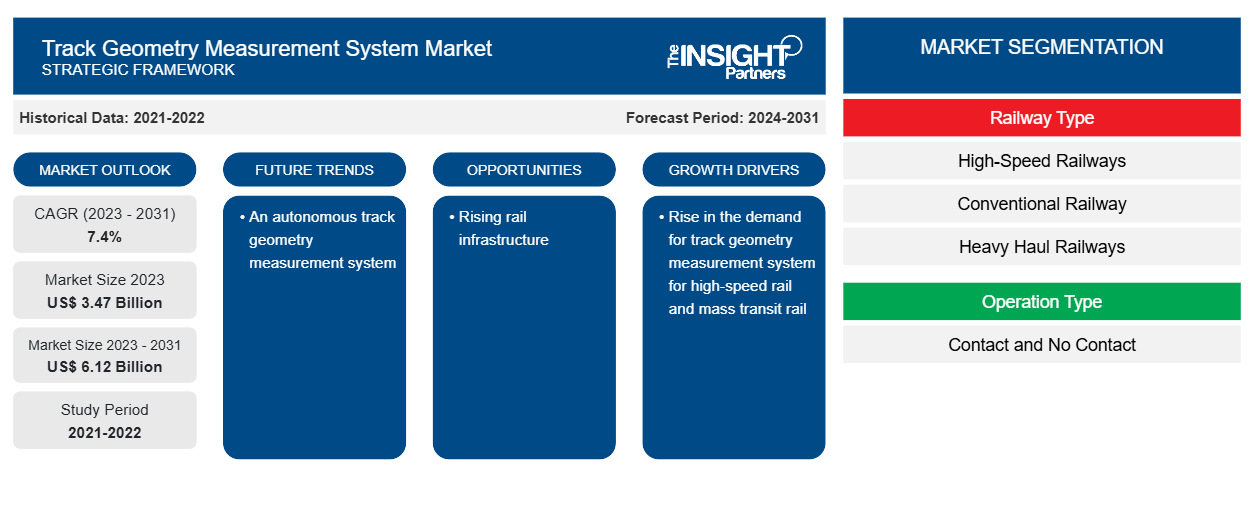Si prevede che la dimensione del mercato dei sistemi di misurazione della geometria dei binari raggiungerà i 6,12 miliardi di dollari entro il 2031, rispetto ai 3,47 miliardi di dollari del 2023. Si prevede che il mercato registrerà un CAGR del 7,4% nel 2023-2031. L'aumento della domanda di soluzioni per aumentare la sicurezza ferroviaria e l'espansione della rete ferroviaria rimarranno probabilmente fondamentali per le tendenze del mercato dei sistemi di misurazione della geometria dei binari.
Analisi di mercato del sistema di misurazione della geometria della pista
Il settore ferroviario è regolato da molteplici normative e standard e, per rispettarli, è necessario un sistema di misurazione della geometria dei binari. La crescente domanda di sicurezza e protezione nel trasporto ferroviario, nonché l'espansione delle reti ferroviarie e delle linee metropolitane, sono fattori chiave della crescita del settore. Numerosi incidenti e contrattempi che coinvolgono i treni hanno sollevato preoccupazioni globali, incoraggiando i governi a digitalizzare la modalità di trasporto per garantire un viaggio più sicuro. Inoltre, la crescente domanda di tecnologie intelligenti per mantenere l'efficienza operativa dei binari sta guidando la crescita del mercato dei sistemi di misurazione della geometria dei binari.
Panoramica del mercato dei sistemi di misurazione della geometria della pista
Nel settore ferroviario, il sistema di misurazione della geometria dei binari è la tecnica più cruciale per valutare la sicurezza dei binari e la pianificazione della manutenzione. Misurare e valutare regolarmente la geometria dei binari aiuta a evitare deragliamenti correlati ai binari, che possono causare danni disastrosi. Le condizioni della geometria dei binari sono una delle cause principali dei deragliamenti da interazione veicolo/binario, come lo scartamento allargato (gauge), la salita delle ruote e i deragliamenti da ribaltamento delle rotaie. Le condizioni della geometria dei binari possono anche causare rotture di rotaie, rotture di elementi di fissaggio e deragliamenti da disallineamento termico. Il sistema di misurazione della geometria dei binari fornisce la capacità critica di garantire che le condizioni della geometria dei binari siano entro limiti accettabili per operazioni sicure.
Personalizza questo report in base alle tue esigenze
Riceverai la personalizzazione gratuita di qualsiasi report, comprese parti di questo report, o analisi a livello nazionale, pacchetto dati Excel, oltre a usufruire di grandi offerte e sconti per start-up e università
-
Scopri le principali tendenze di mercato in questo rapporto.Questo campione GRATUITO includerà analisi di dati che spaziano dalle tendenze di mercato alle stime e alle previsioni.
Driver di mercato e opportunità per il sistema di misurazione della geometria della pista
Aumento della domanda di sistemi di misurazione della geometria dei binari per treni ad alta velocità e treni di trasporto pubblico per favorire il mercato
Si prevede che il mercato globale dei sistemi di misurazione della geometria dei binari si espanderà rapidamente a causa della crescente domanda di treni ad alta velocità. Gli sviluppi dei treni ad alta velocità hanno registrato progressi costanti, incrementando il mercato globale dei sistemi di misurazione della geometria dei binari. Uno dei principali fattori trainanti del mercato dei sistemi di misurazione della geometria dei binari è la presenza di un'ampia gamma di specifiche e normative del settore ferroviario, nonché la necessità di incorporare soluzioni di misurazione della geometria dei binari per conformarsi a tali standard. Altri fattori che guidano il mercato dei sistemi di misurazione della geometria dei binari includono l'introduzione di sistemi di geometria dei binari per la manutenzione dei binari e l'espansione delle reti metropolitane e dei treni ad alta velocità.
Crescente infrastruttura ferroviaria
La domanda globale di trasporti sta aumentando a un ritmo più veloce. Secondo l'Agenzia Internazionale per l'Energia (IEA), nel 2019, si prevede che le attività di trasporto passeggeri e merci raddoppieranno entro il 2050. Secondo il Gruppo della Banca Mondiale, le ferrovie sono uno dei modi più efficienti per trasportare passeggeri e merci. A causa di tali crescenti attività di trasporto, il Gruppo della Banca Mondiale supporta lo sviluppo del settore ferroviario per renderlo più efficiente. Supporta i governi dei paesi in via di sviluppo nella riforma dell'infrastruttura ferroviaria e nell'incorporazione delle ferrovie nella rete di trasporto di un paese. Inoltre, i governi dei paesi in via di sviluppo stanno anche investendo per potenziare il loro settore ferroviario. Secondo l'India Brand Equity Foundation, per l'infrastruttura e lo sviluppo ferroviario, il paese investirà circa 715,41 miliardi di dollari entro il 2030. Tali investimenti e iniziative da parte del governo e delle associazioni stanno stimolando la crescita del settore ferroviario. Pertanto, la crescente infrastruttura ferroviaria genera la domanda di soluzioni per valutare accuratamente la geometria dei binari ferroviari in una varietà di condizioni operative.
Analisi della segmentazione del rapporto di mercato del sistema di misurazione della geometria della pista
I segmenti chiave che hanno contribuito alla derivazione dell'analisi di mercato del sistema di misurazione della geometria dei binari sono la tipologia di ferrovia, il tipo di operazione e il componente.
- Per tipo di ferrovia, il mercato è segmentato in ferrovie ad alta velocità , ferrovie convenzionali, ferrovie per trasporto pesante e ferrovie leggere. Il segmento ferroviario convenzionale ha detenuto la quota di mercato maggiore nel 2023.
- In base al tipo di operazione, il mercato è segmentato in contatto e senza contatto. Il segmento contatto ha detenuto la quota di mercato maggiore nel 2023.
- Per componente, il mercato è segmentato in hardware, software e servizi. Il segmento hardware ha detenuto la quota di mercato maggiore nel 2023.
Analisi della quota di mercato del sistema di misurazione della geometria della pista per area geografica
L'ambito geografico del rapporto di mercato sui sistemi di misurazione della geometria dei binari è suddiviso principalmente in cinque regioni: Nord America, Asia Pacifico, Europa, Medio Oriente e Africa e Sud America/Sud e Centro America.
Si prevede che la regione Asia-Pacifico crescerà con il CAGR più elevato. Il rapido sviluppo dei sistemi ferroviari nella regione richiede soluzioni robuste per migliorare la sicurezza ferroviaria, il che spinge il mercato dei sistemi di misurazione della geometria dei binari nella regione Asia-Pacifico. L'aumento delle reti ferroviarie e delle linee metropolitane nella regione spinge ulteriormente la crescita del mercato dei sistemi di misurazione della geometria dei binari nella regione.
Approfondimenti regionali sul mercato dei sistemi di misurazione della geometria dei binari
Le tendenze regionali e i fattori che influenzano il mercato dei sistemi di misurazione della geometria dei binari durante il periodo di previsione sono stati ampiamente spiegati dagli analisti di Insight Partners. Questa sezione discute anche i segmenti di mercato dei sistemi di misurazione della geometria dei binari e la geografia in Nord America, Europa, Asia Pacifico, Medio Oriente e Africa e Sud e Centro America.

- Ottieni i dati specifici regionali per il mercato del sistema di misurazione della geometria della pista
Ambito del rapporto di mercato del sistema di misurazione della geometria della pista
| Attributo del report | Dettagli |
|---|---|
| Dimensioni del mercato nel 2023 | 3,47 miliardi di dollari USA |
| Dimensioni del mercato entro il 2031 | 6,12 miliardi di dollari USA |
| CAGR globale (2023-2031) | 7,4% |
| Dati storici | 2021-2022 |
| Periodo di previsione | 2024-2031 |
| Segmenti coperti |
Per tipo di ferrovia
|
| Regioni e Paesi coperti |
America del Nord
|
| Leader di mercato e profili aziendali chiave |
|
Sistema di misurazione della geometria della pista Densità degli attori del mercato: comprendere il suo impatto sulle dinamiche aziendali
Il mercato del Track Geometry Measurement System Market sta crescendo rapidamente, spinto dalla crescente domanda degli utenti finali dovuta a fattori quali l'evoluzione delle preferenze dei consumatori, i progressi tecnologici e una maggiore consapevolezza dei vantaggi del prodotto. Con l'aumento della domanda, le aziende stanno ampliando le loro offerte, innovando per soddisfare le esigenze dei consumatori e capitalizzando sulle tendenze emergenti, il che alimenta ulteriormente la crescita del mercato.
La densità degli operatori di mercato si riferisce alla distribuzione di aziende o società che operano in un particolare mercato o settore. Indica quanti concorrenti (operatori di mercato) sono presenti in un dato spazio di mercato in relazione alle sue dimensioni o al valore di mercato totale.
Le principali aziende che operano nel mercato dei sistemi di misurazione della geometria dei binari sono:
- Balfour Beatty S.p.A.
- Azienda: Bentley Systems, Inc.
- Società anonima
- ESIM Srl
- Fuga
- Oroschmidt
Disclaimer : le aziende elencate sopra non sono classificate secondo un ordine particolare.

- Ottieni la panoramica dei principali attori del mercato dei sistemi di misurazione della geometria della pista
Notizie di mercato e sviluppi recenti del sistema di misurazione della geometria della pista
Il mercato del Track Geometry Measurement System viene valutato raccogliendo dati qualitativi e quantitativi dopo la ricerca primaria e secondaria, che include importanti pubblicazioni aziendali, dati associativi e database. Di seguito è riportato un elenco degli sviluppi nel mercato:
- Nel novembre 2023, Brightline ha assegnato un contratto a ENSCO Rail per fornire una tecnologia di ispezione ferroviaria autonoma per la sua rete ampliata in Florida. La tecnologia di misurazione della geometria dei binari e dell'usura delle rotaie di ENSCO utilizza sensori e algoritmi per misurare i parametri delle rotaie in tempo reale e fornire una valutazione completa delle condizioni dei binari della rete. Monitorando autonomamente le condizioni dell'infrastruttura dei binari, questa tecnologia supporta le decisioni di gestione delle risorse per mantenere in servizio la rete ferroviaria di Brightline. (Fonte: Brightline, comunicato stampa, 2023)
Copertura e risultati del rapporto di mercato sul sistema di misurazione della geometria della pista
Il rapporto "Dimensioni e previsioni del mercato del sistema di misurazione della geometria della pista (2021-2031)" fornisce un'analisi dettagliata del mercato che copre le aree sottostanti.
- Dimensioni e previsioni del mercato a livello globale, regionale e nazionale per tutti i segmenti di mercato chiave coperti dall'ambito
- Dinamiche di mercato come fattori trainanti, vincoli e opportunità chiave
- Principali tendenze future
- Analisi dettagliata delle cinque forze PEST/Porter e SWOT
- Analisi di mercato globale e regionale che copre le principali tendenze di mercato, i principali attori, le normative e gli sviluppi recenti del mercato
- Analisi del panorama industriale e della concorrenza che copre la concentrazione del mercato, l'analisi della mappa di calore, i principali attori e gli sviluppi recenti
- Profili aziendali dettagliati
- Analisi storica (2 anni), anno base, previsione (7 anni) con CAGR
- Analisi PEST e SWOT
- Valore/volume delle dimensioni del mercato - Globale, Regionale, Nazionale
- Industria e panorama competitivo
- Set di dati Excel
Report recenti
Testimonianze
Motivo dell'acquisto
- Processo decisionale informato
- Comprensione delle dinamiche di mercato
- Analisi competitiva
- Analisi dei clienti
- Previsioni di mercato
- Mitigazione del rischio
- Pianificazione strategica
- Giustificazione degli investimenti
- Identificazione dei mercati emergenti
- Miglioramento delle strategie di marketing
- Aumento dell'efficienza operativa
- Allineamento alle tendenze normative























 Ottieni un campione gratuito per - Mercato dei sistemi di misurazione della geometria della pista
Ottieni un campione gratuito per - Mercato dei sistemi di misurazione della geometria della pista